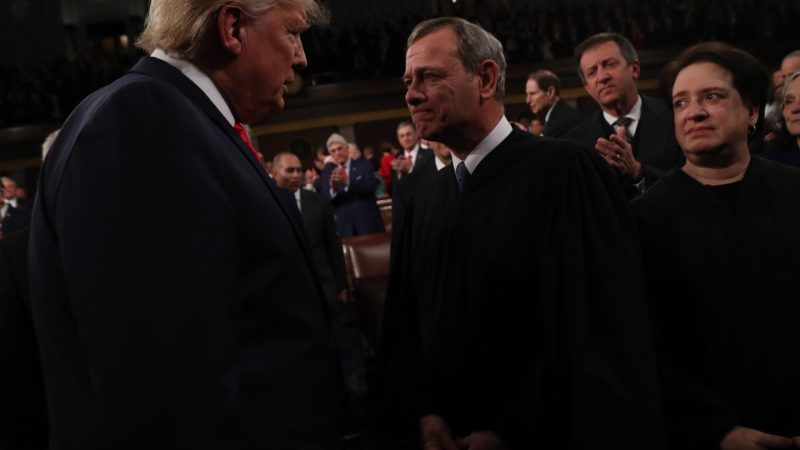The Looming Supreme Court Showdown Over Sanctuary Cities
The legal battle over immigration, federalism, and executive power heats up.

The Trump administration has claimed the unilateral authority to withhold federal funding from sanctuary cities, jurisdictions whose officials refuse to participate in the enforcement of federal immigration laws. In a flawed ruling issued this week, the U.S. Court of Appeals for the 2nd Circuit gave its blessing to the administration's constitutionally defective behavior.
The case is New York v. Department of Justice. It centers on the Trump administration's 2017 rule setting new conditions on all applicants to the Edward Byrne Memorial Justice Assistance Grant Program, a federal funding scheme passed by Congress that annually provides more than $250 million to state and local law enforcement.
"So-called 'sanctuary' policies make all of us less safe because they intentionally undermine our laws and protect illegal aliens who have committed crimes," declared then–Attorney General Jeff Sessions when he announced the new rule. "From now on, the [Justice] Department will only provide Byrne JAG grants to cities and states that comply with federal law, allow federal immigration access to detention facilities, and provide 48 hours notice before they release an illegal alien wanted by federal authorities."
The 2nd Circuit found nothing wrong with that. "There is something disquieting in the idea of States and localities seeking federal funds to enforce their own laws while themselves hampering the enforcement of federal laws," the court said. Fortunately for the Trump administration, the 2nd Circuit found a way to silence its disquiet by interpreting the federal statute authorizing the Byrne grants in a manner that, in the court's words, "confers considerable authority on the attorney general."
There are two big problems with the 2nd Circuit's approach. First, the federal spending power is located in Article I, the section of the Constitution that spells out the powers of Congress. The powers of the executive branch are enumerated separately in Article II. So the attorney general has no independent authority to dictate the terms of federal spending. To hold otherwise is to greenlight a violation of the constitutional separation of powers.
Second, the 2nd Circuit's judgment runs afoul of Supreme Court precedent. In Pennhurst State School and Hospital v. Halderman (1981), the Court held that Congress must "speak with a clear voice" when it exercises its spending power. "If Congress intends to impose a condition on the grant of federal moneys," the Court said, "it must do so unambiguously." The federal statute authorizing the Byrne grants makes no mention of any immigration-related conditions.
The 2nd Circuit's judgment also stands in stark contrast to that of the U.S. Court of Appeals for the 7th Circuit, which also reviewed the administration's actions on this front and reached a very different conclusion. "The Attorney General in this case used the sword of federal funding to conscript state and local authorities to aid in federal civil immigration enforcement," the 7th Circuit observed in Chicago v. Sessions (2018). "But the power of the purse rests with Congress, which authorized the federal funds at issue and did not impose any immigration enforcement conditions on the receipt of such funds….It falls to us, the judiciary, as the remaining branch of government, to act as a check on such usurpation of power."
A circuit split as glaring as that may well attract the attention of the Supreme Court. In the meantime, another sanctuary cities case is already knocking on the justices' courtroom door.
At issue in United States v. California is the Trump administration's 2018 lawsuit against the Golden State over the California Values Act of 2017. Among other things, that law prohibits state and local police from assisting federal immigration authorities in various ways, such as "detaining an individual on the basis of a [federal immigration] hold request"; "transfer[ring] an individual to immigration authorities unless authorized by a judicial warrant or judicial probable cause determination"; and "providing information" to federal immigration authorities "regarding a person's release date…or other information unless that information is available to the public, or is in response to a notification request from immigration authorities in accordance with" California law.
The administration thinks those state instructions to state officials illegally "undermine federal immigration enforcement," and in November it filed a petition asking the Supreme Court to take up the case. The administration should probably be more careful about what it wishes for. As I've previously written, "if the Supreme Court does agree to hear the case, the justices may well take the opposite view. Indeed, if the Court follows a precedent authored by the late Justice Antonin Scalia, the Trump administration is likely to lose."
That precedent is Printz v. United States (1997). At issue was a provision of the 1993 Brady Handgun Violence Prevention Act that required local police to help enforce federal gun control law. "The Federal Government may neither issue directives requiring the States to address particular problems," declared Justice Scalia's majority opinion, "nor command the States' officers, or those of their political subdivisions, to administer or enforce a federal regulatory program."
The same 10th Amendment principles that make it unconstitutional for the feds to commandeer the states into enforcing federal gun control regulations also make it unconstitutional for the feds to commandeer the states into enforcing federal immigration regulations.
Each of these sanctuary city cases raises important constitutional questions. Eventually, the Supreme Court will need to come to grips with one or more of them.



Show Comments (47)